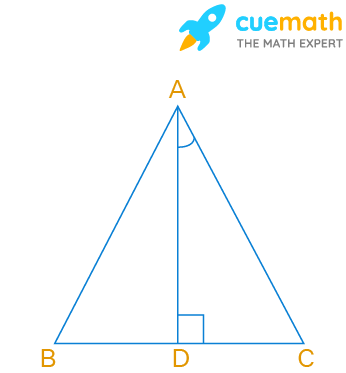In an equilateral triangle ABC (Fig. 6.2), AD is an altitude. Then 4AD² is equal to
a. 2BD²
b. BC²
c. 3AB²
d. 2DC²

Solution:
Given, ABC is an equilateral triangle with AD as altitude.
We have to find the value of 4AD².
We know that in an equilateral triangle all the sides are of equal length.
Let AB = BC = AC = x units --------- (1)
Let AD = h units ---------------------- (2)
In an equilateral triangle, the altitude AD bisects BC
So, BD = CD = BC/2 = x/2
Considering triangle ADB,
We observe that ADB is a right angle triangle with D equal to 90 degrees.
AD² + BD² = AB²
(h)² + (x/2)² = (x)²
h² + x²/4 = x²
h² = x² - x²/4
h² = [(4-1)/4]x²
h² = (3/4)x²
4h² = 3x²
From (1) and (2),
4AD² = 3AB² = 3BC² = 3AC²
Therefore, 4AD² = 3AB²
✦ Try This: In ∆PQR, ∠P = 70°, ∠Q = 65 ° then find ∠R
☛ Also Check: NCERT Solutions for Class 7 Maths Chapter 6
NCERT Exemplar Class 7 Maths Chapter 6 Sample Problem 2
In an equilateral triangle ABC (Fig. 6.2), AD is an altitude. Then 4AD² is equal to, a. 2BD², b. BC², c. 3AB², d. 2DC²
Summary:
In an equilateral triangle ABC (Fig. 6.2), AD is an altitude. Then 4AD² is equal to 3AB²
☛ Related Questions:
- In Fig. 6.1, side QR of a ∆PQR has been produced to the point S. If ∠PRS = 115° and ∠P = 45°, then ∠ . . . .
- Which of the following cannot be the sides of a triangle? a. 3 cm, 4 cm, 5 cm, b. 2 cm, 4 cm, 6 cm, . . . .
- Which one of the following is not a criterion for congruence of two triangles? a. ASA, b. SSA, c. SA . . . .
visual curriculum